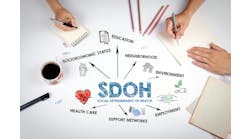CareFirst BlueCross BlueShield, the largest health plan in the mid-Atlantic region, is expanding its relationship with Socially Determined, a healthcare analytics company that delivers social risk analytics and advisory services.
In a recent interview with Healthcare Innovation, Djinge Lindsay, M.D., M.P.H., CareFirst’s director of public health, and Trenor Williams, M.D., Socially Determined’s founder and CEO, discussed the goals of CareFirst’s enterprise-wide use of the SocialScape platform.
Williams said his company was founded in 2017 with a pretty simple idea. “The problem we were trying to solve for was the lack of visibility into data and insights outside of the traditional healthcare setting,” he said. “How do you better understand what drives the decisions that people and families have to make regarding their health and their healthcare? We built an analytics platform that allows us to characterize and quantify social risks at a social domain level — around food, housing, financial strain, etc.”
Lindsay noted that the BlueCross BlueShield Association has taken a stance that its plans have to do their part in achieving health equity for the nation. “We're working on looking at four conditions where we know there have been historical disparities: maternal health, behavioral health, diabetes, and cardiovascular disease,” she said.
One of the first steps, she explained, is understanding where there are inequities or disparities — being able to look at the population health outcomes from a racial and geographic disparity lens, and someday in the future, also having some insight into sexual orientation and identity, and disability status. “That is our wider goal. If we understand where there are disparities, then there has to be something driving those inequities. That is where this understanding of social risk, and the social constructs that are influencing our members is going to become very helpful,” Lindsay said.
CareFirst initially engaged Socially Determined to provide intelligence and support for its $10.5 million investment in the State of Maryland’s Diabetes Action Plan, a statewide effort to address the diabetes epidemic.
Socially Determined offered insights used to deploy resources to communities and populations where they would have the most impact. For example, the team identified that within CareFirst’s commercial health plan, members with diabetes who also faced elevated risk of food insecurity and health literacy issues had an annual total cost of care that was over $3,000 higher than similar members who did not face the same social risks. Empowered by this information, CareFirst designed tailored, multi-factor interventions to meet the specific needs of these people.
“We understand that it's not just care for our members that we need to be impacting; we also want to have a focus on our larger community,” Lindsay said. “We were able to use the community data Socially Determined provided, and we also could look at some of our member data looking at cost of care. We were able to say we should be looking at communities that have high risk for health illiteracy and high risk for food insecurity, in terms of where we want to direct these diabetes investment dollars. Our entire grant strategy was built off of that data that Socially Determined provided.”
Williams said his company is able to run disparate data through specific algorithms to not just create a risk score, but also understand what's the primary driver of somebody's food insecurity, or a community's food insecurity. “We break each of our risk domains into three primary drivers for food: its affordability, accessibility of healthy food and food literacy,” he said, “so we are able to start to understand not just is somebody at risk, but how are you actually going to solve that problem, which, for me, is the most important thing.”
He said the company creates a profile at a community level and an individual level. “We then integrate that with healthcare data, either clinical data from the EHR or claims data, like from CareFirst’s claims processing system. It is not just health data and not just social data, but a combination of the two, and you can start to quantify where it looks like social risk is actually impacting financial and clinical outcomes,” he said. “We then help organizations determine what's the best place to use that information, in terms of where they make their investments.”
Lindsay said that by being able to get some more exacting data, CareFirst can have some more precise strategies. “For example, we knew there were going to be issues during the COVID 19 pandemic. We had a food delivery program set up initially for high-risk pregnancy, because it might be an extra burden for these women to get out of their home to get groceries. We wanted to make sure they're getting good nutrition, and that upfront support is going to hopefully ameliorate any bad pregnancy outcomes. There'll be a healthy mom and child as well as cost savings for us as a payer. But when the pandemic hit, we understood that was going to be an issue not just for our high-risk moms, but likely all of our moms, particularly those with other kids at home. We expanded that program to allow that service for all of our prenatal members. Having pretty robust data on our entire membership, we can be more savvy about those approaches and those strategies.”
Williams said an organization like CareFirst doesn’t have the resources to invest the same way in all 24 counties in Maryland and all eight wards in D.C., so the challenge is to use the data to create a precise investment strategy and to find the type of partners it needs to address the challenges of the community. For example, he said, Prince George's County is a big and very diverse county. “You can't have a county strategy. right? You have to understand the specific needs of micro-communities that are there.”
He also said the expansion of the partnership with CareFirst includes every product line and all members. “One of the myths around social risk is that this must only impact people who either don't have insurance or have Medicaid as their primary insurance,” Williams said. “The reality is that we see unbelievable impact and variation in every population. We forget sometimes commercially insured individuals. Across the country working with other payers, we see lower-wage workers who might have a higher deductible, but who don't qualify for federal and state, programs, have real risk. How do you start to think about that? We're working with the commercial teams at CareFirst on how they support those commercially insured individuals and the employer contracts that they have as part of that.”
Lindsay said the tool is only as good as how well you use it. “We are kind of crawling with this right now. I think that as we start to walk and then run a bit more, there are going to be implications for how we look at our benefit design, how we look at marketing and outreach, and how we look at our clinical program supports,” she said. “There's a wide swath of implications. As a health insurer, we want healthy members. That can't just be clinical interventions. We have to get more savvy across the board, in terms of understanding how social risks are influencing our members, all the different levers that we can use to to improve health outcomes based on that.”
Williams added that it is important to start to measure that impact of all these interventions that Dr. Lindsay has talked about. “Financial measurement certainly will be part of it, but clinical outcomes, community impact, and retention, too. No matter how good risk scores might be and how much of an opportunity you can identify, if it doesn't lead to action, and allow your partners to be able to act on it, and then grow and scale what's working, it doesn't really matter. Everything that we think about is how do you empower organizations to act, measure it, and then empower them to act and scale up what's really working.”


